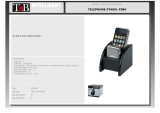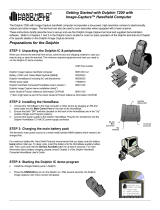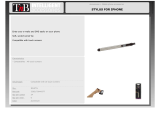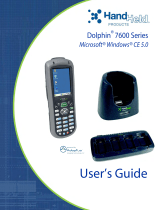Page is loading ...

Dolphin
™
6500 Mobile Computer
with Windows
®
Embedded Handheld 6.5
User’s Guide

Disclaimer
Honeywell International Inc. (“HII”) reserves the right to make changes in specifications and other infor-
mation contained in this document without prior notice, and the reader should in all cases consult HII to
determine whether any such changes have been made. The information in this publication does not rep-
resent a commitment on the part of HII.
HII shall not be liable for technical or editorial errors or omissions contained herein; nor for incidental or
consequential damages resulting from the furnishing, performance, or use of this material.
This document contains proprietary information that is protected by copyright. All rights are reserved.
No part of this document may be photocopied, reproduced, or translated into another language without
the prior written consent of HII.
Web Address: www.honeywellaidc.com
Trademarks
Dolphin is a trademark or registered trademark of Hand Held Products, Inc. or Honeywell International Inc.
Microsoft, Windows, Windows Mobile, Windows Embedded Handheld, Windows CE, Windows NT,
Windows 2000, Windows ME, Windows XP, ActiveSync, Outlook, and the Windows logo are trademarks
or registered trademarks of Microsoft Corporation.
Other product names mentioned in this manual may be trademarks or registered trademarks of their
respective companies and are the property of their respective owners.
Other Trademarks
The Bluetooth trademarks are owned by Bluetooth SIG, Inc., U.S.A. and licensed to Honeywell
International Inc.
Patents
For patent information, please refer to www.honeywellaidc.com/patents.
©2011-2012 Honeywell International Inc. All rights reserved.

iii
Chapter 1 - Agency Approvals
Label Locations....................................................................................................................1-1
Safety & RF Approvals by Country: .....................................................................................1-2
Dolphin RF Terminal—802.11b/g and/or Bluetooth .............................................................1-3
Chapter 2 - Getting Started
Out of the Box ......................................................................................................................2-1
LED Indicators................................................................................................................2-2
Home Screen .......................................................................................................................2-4
Title Bar................................................................................................................................2-4
Horizontal Scroll...................................................................................................................2-5
Tile Bar.................................................................................................................................2-6
Pop-Up Menus .....................................................................................................................2-6
Selecting Programs..............................................................................................................2-6
File Explorer.........................................................................................................................2-7
Chapter 3 - Terminal Hardware Overview
Standard Terminal Configurations .......................................................................................3-1
Front Panel Features ...........................................................................................................3-2
Using Screen Protectors ......................................................................................................3-3
Removing the Screen Protector .....................................................................................3-4
Back Panel Features............................................................................................................3-8
Installing Memory Cards ................................................................................................3-9
Left Side Panel Features ...................................................................................................3-10
Right Side Panel Features .................................................................................................3-10
Top Panel Features ...........................................................................................................3-11
Bottom Panel Features ......................................................................................................3-11
Dolphin Peripherals/Accessories for the Dolphin 6500......................................................3-12
USB Communication Cable for the Dolphin 6500..............................................................3-12
Battery Power ....................................................................................................................3-13
Managing Main Battery Power .....................................................................................3-14
Resetting the Terminal.......................................................................................................3-16
Soft Reset (Warm Boot) ...............................................................................................3-16
Hard Reset (Cold Boot)................................................................................................3-16
Suspend Mode...................................................................................................................3-16
Care and Cleaning of the Dolphin Terminal.......................................................................3-17
Dolphin 6500 Technical Specifications ..............................................................................3-18
Chapter 4 - Using the Keypad
Overview ..............................................................................................................................4-1
Navigation Keys ...................................................................................................................4-1
Basic Keys ...........................................................................................................................4-2
Alpha/Numeric Modes..........................................................................................................4-2
Alpha Indicators on the Number Keys............................................................................4-2
Table of Contents

iv
Function Key Combinations................................................................................................. 4-3
CTRL Key Combinations ..................................................................................................... 4-4
Program Buttons.................................................................................................................. 4-5
Chapter 5 - Using the Image Engine
Overview.............................................................................................................................. 5-1
Available Engines ................................................................................................................ 5-1
Depth of Field ................................................................................................................ 5-1
Supported Bar Code Symbologies ..................................................................................... 5-2
Activating the Engine...........................................................................................................5-3
Decoding ............................................................................................................................. 5-3
Capturing Images (5300 Engine only) ................................................................................. 5-4
Chapter 6 - Using the Laser Engine
Overview.............................................................................................................................. 6-1
Available Engines ................................................................................................................ 6-1
Depth of Field - IS4813.................................................................................................. 6-1
Supported Bar Code Symbologies ..................................................................................... 6-1
Activating the Engine...........................................................................................................6-2
Decoding a Bar Code .......................................................................................................... 6-2
Chapter 7 - System Settings
Overview.............................................................................................................................. 7-1
Clock & Alarms .................................................................................................................... 7-2
Personal Menu .................................................................................................................... 7-3
Buttons........................................................................................................................... 7-3
System Menu....................................................................................................................... 7-6
About ............................................................................................................................. 7-7
Backlight ........................................................................................................................ 7-7
Certificates..................................................................................................................... 7-8
Customer Feedback ...................................................................................................... 7-8
Encryption......................................................................................................................7-9
Error Reporting .............................................................................................................. 7-9
External GPS................................................................................................................. 7-9
Managed Programs ..................................................................................................... 7-10
Memory........................................................................................................................ 7-10
Power...........................................................................................................................7-11
Regional Settings......................................................................................................... 7-12
Remove Programs....................................................................................................... 7-13
Screen ............................................................................................................................... 7-14
Task Manager....................................................................................................................7-15
Chapter 8 - Communication
Connecting the Dolphin 6500-USB Communication Cable ................................................. 8-1
Charging Terminal with USB Cable..................................................................................... 8-1
Connections Menu............................................................................................................... 8-3

v
Connections Manager ......................................................................................................... 8-4
To Access the Connections Manager............................................................................ 8-4
Tasks ............................................................................................................................. 8-4
Advanced....................................................................................................................... 8-5
Dolphin Wireless Manager .................................................................................................. 8-6
Dolphin Wireless Manager Window............................................................................... 8-7
Enabling the Radios....................................................................................................... 8-7
Accessing Radio Configuration Utilities......................................................................... 8-8
Network Cards..................................................................................................................... 8-8
Connecting and Synchronizing the Terminal and Workstation............................................ 8-9
Installing Additional Software ............................................................................................ 8-11
Adding Programs Using ActiveSync or Windows Mobile Device Center..................... 8-11
Connecting the Terminal to a Wireless Network.......................................................... 8-12
Adding Programs Using the Internet............................................................................ 8-12
Software Upgrades............................................................................................................ 8-13
Chapter 9 - Working with the Bluetooth Radio
Enabling the Bluetooth Radio .............................................................................................. 9-1
Pairing and Trusted Devices ............................................................................................... 9-2
Connecting to Other Bluetooth Devices .............................................................................. 9-2
Transferring Files................................................................................................................. 9-4
Making the Terminal Discoverable ...................................................................................... 9-6
Chapter 10 - Dolphin HomeBase/eBase Device
Overview............................................................................................................................ 10-1
Front Panel ....................................................................................................................... 10-2
Back Panel ....................................................................................................................... 10-3
Powering the Dolphin HomeBase Device.......................................................................... 10-4
eBase Clamp-on Ferrite Core Installation ......................................................................... 10-4
Charging the Main Battery................................................................................................. 10-5
Charging a Spare Battery ............................................................................................ 10-6
Checking Battery Power .................................................................................................... 10-6
Technical Specifications .................................................................................................... 10-7
Chapter 11 - Dolphin QuadCharger Device
Overview............................................................................................................................ 11-1
QuadCharger Device ........................................................................................................ 11-1
Battery Charging................................................................................................................ 11-2
Recommendations for Storing Batteries............................................................................ 11-3
Troubleshooting................................................................................................................. 11-3
Technical Specifications .................................................................................................... 11-4
Chapter 12 - Dolphin 6500 Net Base Device
Overview............................................................................................................................ 12-1

vi
Parts and Functions........................................................................................................... 12-2
Front Panel .................................................................................................................. 12-2
Back Panel .................................................................................................................. 12-3
Bottom Panel ............................................................................................................... 12-4
Power ................................................................................................................................ 12-4
Connecting Power to the Net Base.............................................................................. 12-4
Charging the Main Battery................................................................................................. 12-5
To Power a Terminal and Charge its Main Battery...................................................... 12-5
Communication.................................................................................................................. 12-5
Software Requirements ............................................................................................... 12-5
Connecting the Dolphin Terminal to the Net Base ............................................................ 12-5
Mounting the Net Base ...................................................................................................... 12-6
Chapter 13 - Dolphin 6500 Slide-On Handle
Overview............................................................................................................................ 13-1
Removing the Hand Strap ........................................................................................... 13-1
Installing the Handle/Removing the Handle................................................................. 13-1
Chapter 14 - Customer Support
Product Service and Repair............................................................................................... 14-1
Limited Warranty ............................................................................................................... 14-1
Limited Warranty Duration................................................................................................. 14-2
How to Extend Your Warranty ..................................................................................... 14-2

1 - 1
1
Agency Approvals
Label Locations
Dolphin 6500 mobile computers meet or exceed the requirements of all applicable standards
organizations for safe operation. However, as with any electrical equipment, the best way to ensure safe
operation is to operate them according to the agency guidelines that follow. Read these guidelines
carefully before using your mobile computer.
Laser Light Label
Compliance Label
Laser Light Label
LASER LIGHT. DO NOT STARE INTO BEAM
CLASS 2 LASER PRODUCT
1.0 mW MAX OUTPUT: 650nM
IEC60825-1: 1993+A1+A2
Complies with 21 CFR 1040.10 and 1040.11
except for deviations pursuant to Laser
Notice No. 50, dated June 24, 2007.

1 - 2
Safety & RF Approvals by Country:
* Does not apply to IS4813 laser engine.
R&TTE Compliance Statement—802.11b/g and/or Bluetooth
Dolphin RF terminals are in conformity with all essential requirements of the R&TTE Directive (1999/5/
EC).
This product is marked with in accordance with the Class II product requirements specified
in the R&TTE Directive, 1999/5/EC. The equipment is intended for use throughout the European
Community; PAN European Frequency Range: 2.402–2.480 GHz.
Restrictions for use in France are as follows:
• Indoor use: Maximum power (EIRP*) of 100 mW for the entire 2.400–2.4835 GHz
• Outdoor use: Maximum power (EIRP*) of 100 mW for the 2.400–2.454 GHz band & maximum power
(EIRP*) of 10 mW for the 2.454–2.483 MGHz band.
The CE Mark on the product indicates that the system has been tested to and conforms with the
provisions noted within the 2004/108/EC Electromagnetic Compatibility Directive and the 2006/95/
EC Low Voltage Directive. Honeywell shall not be liable for use of our product with equipment (i.e.,
power supplies, personal computers, etc.) that is not CE marked and does not comply with the Low
Voltage Directive.
For further information, contact:
Honeywell Imaging & Mobility Europe BV
Nijverheidsweg 9
5627 BT Eindhoven
The Netherlands
Country Safety RF (Radio)
U.S.A. UL60950-1 FCC Part 15, Sub part B, Sub
part C
Canada* C-UL CSA C22.2 No. 60950-1-03 ICES-003, RSS 210
European
Community
IEC 60825-1:1993+A1:1997+A2:2001 EN55022 (CISPR 22) Class B
EN55024:1998
EN300 328
EN301 489-1
EN301 489-7
EN301 489-17
IEC 62209-2
China CCC SRRC
Japan PSE AIRB
Australia EN60950 AS/NZS4268
Brazil* ANATEL
Mexico* NOM-019 COFETEL
New Zealand EN60950 AS/NZS4268
!
0983

1 - 3
Laser Safety Label
If the following label is attached to your product, it indicates the product contains
an imager engine with a laser aimer (5300) or a laser engine (IS4813).
Laser Eye Safety Statement: This device has been tested in accordance with
and complies with IEC60825-1: 1993+A1+A2 and 21 CFR 1040.10 and
1040.11, except for deviations pursuant to Laser Notice No. 50, dated June 24,
2007. LASER LIGHT, DO NOT STARE INTO BEAM, CLASS 2 LASER PRODUCT, 1.0 mW MAX
OUTPUT: 650nM.
This class 2 laser product is in accordance with the requirements of IEC60825-1 Ed. 1.2 Clause 6.2(a).
Caution - use of controls or adjustments or performance of procedures other than those specified herein
may result in hazardous radiation exposure.
LED Safety Statement
The LED output on this device has been tested in accordance with IEC60825-1 LED safety and certified
to be under the limits of a Class 1 LED device.
CB Scheme
Certified to CB Scheme IEC 60950-1.
FCC RF Radiation Exposure Statement
This equipment complies with FCC RF radiation exposure limits set forth for an uncontrolled environment.
Dolphin RF Terminal—802.11b/g and/or Bluetooth
This device complies with Part 15 of the FCC Rules. Operation is subject to the following two conditions:
(1) this device may not cause harmful interference, and (2) this device must accept any interference
received, including interference that may cause undesired operation.
This equipment has been tested and found to comply with the limits for a Class B digital device pursuant
to Part 15 of the FCC Rules. These limits are designed to provide reasonable protection against harmful
interference in a residential installation. This equipment generates, uses, and can radiate radio frequency
energy and, if not installed and used in accordance with the instructions, may cause harmful interference
to radio communications. However, there is no guarantee that interference will not occur in a particular
installation. If this equipment does cause harmful interference to radio or television reception, which can
be determined by turning the equipment off and on, the user is encouraged to try to correct the
interference by one or more of the following measures:
• Reorient or relocate the receiving antenna.
• Increase the separation between the equipment and receiver.
• Connect the equipment into an outlet on a circuit different from that to which the receiver is connected.
• Consult the dealer or an experienced radio/TV technician for help.
If necessary, the user should consult the dealer or an experienced radio/television technician for
additional suggestions. The user may find the following booklet helpful: “Something About Interference.”
This is available at FCC local regional offices. Our company is not responsible for any radio or television
interference caused by unauthorized modifications of this equipment or the substitution or attachment of
connecting cables and equipment other than those specified by our company. The correction is the
responsibility of the user. Use only shielded data cables with this system.
In accordance with FCC 15.21, changes or modifications not expressly approved by the party responsible
for compliance could void the user’s authority to operate the equipment.
LASER LIGHT. DO NOT STARE INTO BEAM
CLASS 2 LASER PRODUCT
1.0 mW MAX OUTPUT: 650nM
IEC60825-1: 1993+A1+A2
Complies with 21 CFR 1040.10 and 1040.11
except for deviations pursuant to Laser
Notice No. 50, dated June 24, 2007.

1 - 4
This device and its antenna must not be co-located or operating in conjunction with any other
antenna or transmitter. To maintain compliance with FCC RF exposure guidelines for body-
worn operation, do not use accessories that contain metallic components.
CAUTION! Any changes or modifications not expressly approved by the grantee of this device could
void the user's authority to operate the equipment.
Canadian Compliance
This Class B digital apparatus complies with Canadian ICES-003. Operation is subject to the following
two conditions: (1) this device may not cause harmful interference, and (2) this device must accept any
interference received, including interference that may cause undesired operation.
To prevent radio interference to the licensed service, this device is intended to be operated indoors and
away from windows to provide maximum shielding. Equipment (or its transmit antenna) installed outdoors
is subject to licensing.
Cet appareil numérique de la Classe B est conforme à la norme NMB-003 du Canada.
For European Community Users
Honeywell complies with Directive 2002/96/EC OF THE EUROPEAN PARLIAMENT AND OF THE
COUNCIL of 27 January 2003 on waste electrical and electronic equipment (WEEE).
Waste Electrical and Electronic Equipment Information
This product has required the extraction and use of natural resources for its production. It may contain
hazardous substances that could impact health and the environment, if not properly disposed.
In order to avoid the dissemination of those substances in our environment and to diminish the pressure
on the natural resources, we encourage you to use the appropriate take-back systems for product
disposal. Those systems will reuse or recycle most of the materials of the product you are disposing in a
sound way.
The crossed out wheeled bin symbol informs you that the product should not be disposed of along
with municipal waste and invites you to use the appropriate separate take-back systems for product
disposal.
If you need more information on the collection, reuse, and recycling systems, contact your local or
regional waste administration.
You may also contact your supplier for more information on the environmental performances of this
product.
!

2 - 1
2
Getting Started
Out of the Box
Verify that your carton contains the following items:
• Dolphin 6500 mobile computer (the terminal)
• Main battery pack (3.7v, Li-Ion)
• AC power supply
• Localized plug adapters
Note: Be sure to keep the original packaging in case you need to return the Dolphin terminal for service; see
Technical Assistance on page 14-1.
Step 1. Install the Main Battery
The Dolphin 6500 is shipped with the battery packaged separate from the unit. Follow the steps below to
install the main battery.
1. Release the strap making it convenient to reach the cover.
2. Remove the battery compartment cover by turning the cover’s locks upward and removing the
cover.
3. Insert the battery into the battery well with the labels facing upward.
4. Replace the cover with a hinging motion and turn the locks downwards.
Note: The battery door must be installed prior to booting the unit.
Cover Locks
Main Battery

2 - 2
5. Replace the hand strap.
We recommend use of Honeywell Li-Ion battery packs. Use of any non-Honeywell battery may result in damage not
covered by the warranty.
Step 2. Charge the Batteries
We recommend use of Honeywell peripherals, power cables, and power adapters. Use of any non-
Honeywell peripherals, cables, or power adapters may cause damage not covered by the warranty.
Ensure all components are dry prior to mating terminals/batteries with peripheral devices. Mating wet
components may cause damage not covered by the warranty.
!
Dolphin 6500s ship with both the main battery pack
and internal backup battery significantly
discharged of power. Charge the main battery
pack with the Dolphin charging cable until the LED
turns green (red while charging). The average
charge time for a fully depleted main battery is
5 1/2 hours. It takes less time if the battery has
some charge.
1. Attach the appropriate plug adapter to the
plug of the power cable.*
2. Insert the plug into the appropriate power
source.
3. Plug the Dolphin power cable into the DC
Power Jack (see page 3-11) on the bottom
end of the unit.
Note: If you remove the battery pack or it completely
discharges, there is a 30 minute window in which
to insert a charged battery pack before the
backup battery completely discharges. If your
backup battery completely discharges, the
contents of the RAM memory will be lost. If your
backup battery is less than fully charged, there is
a proportionally smaller window of time available.
LED Indicators
*This power cable can also be used to power the
Dolphin 6500 while in the Dolphin HomeBase/
eBase Device (see page 10-1).
Red LED On
Charging
Green LED On
Battery is fully charged
1
2
3
!
!
!

2 - 3
The power adapter on the power cable converts the voltage from the power source to 5 volts DC. Only
power adapter cables from Honeywell convert the voltage appropriately. The power cable contains a plug
adapter for each geography (US, UK, EU, etc.).
Step 3. Boot the Terminal
The terminal begins booting as soon as power is applied and runs by itself. Do NOT press any keys or
interrupt the boot process.
When the boot process is complete, the Desktop appears, and the terminal is ready for use.
Step 4. Set the Time Zone, Time, and Date
On the Home screen, tap the line that displays the time and date.
The Clock Settings screen appears.
Tap the arrow to the right of the time zone to open the drop down menu. Select the appropriate time
zone from the menu. Set the correct time and date in the remaining fields and tap OK to save.
Power Adapter
Plug Adapter
Power Cable

2 - 4
Home Screen
After the Dolphin terminal initializes the first time, you see the Home screen.
Tap to reach the Start screen from the home screen.
Tap to access the Dolphin Wireless Manager (see page 8-6) from the home screen.
For more information about the touch screen, see Touch Screen Display on page 3-2.
Title Bar
The Title bar, located at the top of the screen, displays the active program, the status of various system
functions, and the current time. Tapping on the title bar provides access to the Horizontal Scroll. The
scroll provides access to additional programs and application screens. For additional information, see
Horizontal Scroll on page 2-5.
Text here indicates
the active program.
Icons here indicate the
status of various system
functions.

2 - 5
Horizontal Scroll
Indicator Meaning
Synchronizing data
The terminal could not synchronize data with the workstation via ActiveSync.
New e-mail
New text message
New voicemail
New instant message
Ringer off
A battery error has occurred. Replace the main battery pack with a Honeywell Li-poly or Li-ion
battery pack.
Battery is has a full charge
Battery has a high charge
Battery has a medium charge
Battery has a low charge
Battery has a very low charge and requires charging
Terminal is running on external power. If a battery pack is installed, the battery is charging in the
background.
The terminal is not connected to external power. A battery is installed, but is defective; specifically,
its charge level cannot be measured.
Active network connection
No active network connection
Wi-Fi is on, but device is not connected
Wi-Fi data call
Pending alarm
Bluetooth

2 - 6
The Horizontal Scroll, located at the top of most application windows, provides access to additional
application screens. You can flick left or right on the scroll or tap each label on the scroll, until you get to
the desired screen. Tapping a label to the left or right of the center item brings new labels into view.
Note: Tap the Title bar to access the horizontal scroll if it is not visible on the screen.
Tile Bar
The Tile bar is located at the bottom of application windows.
Pop-Up Menus
With pop-up menus, you can quickly choose an action for a selected item. To access a pop-up menu, tap
and hold the stylus on the item name of the action you want to perform. When the menu appears, lift the
stylus, and tap the action you want to perform.
Tap anywhere outside the menu to close the menu without performing an action.
Selecting Programs
To see the programs loaded on your terminal, tap to access the Start Menu. To open a
program, tap once on the program icon. To reposition an icon on the Start Menu, tap and hold the stylus
on the icon, then drag the icon to the desired position.
The content of the
Horizontal scroll
changes according to
the open application.
The icons change according to the open application.
The Task tray displays icons
for programs running in the
background.
The Tile bar displays icons you
use to open and close screens,
menus, and features.

2 - 7
File Explorer
You can also use the File Explorer to find files and organize these files into folders.
1. Tap > File Explorer .
2. Tap the Up button at the bottom of the screen to move up one level in the directory.
3. You can move files in File Explorer by tapping and holding on the item you want to move, then
tapping Cut or Copy on popup menu.
4. Navigate to the folder you want to move the file to, then tap and hold a blank area of the window.
5. Tap Paste on the pop-up menu.
Note: If there is no blank space available in the window, tap
Menu
on the command bar, navigate to the end of the
menu using the down arrow, then tap
Edit
>
Paste
.

2 - 8

3 - 1
3
Terminal Hardware Overview
Dolphin 6500 terminals include a number of standard terminal configurations as well as charging and
communication peripherals and accessories to maximize the efficiency of your application setting.
Standard Terminal Configurations
There are two standard Dolphin 6500 configurations: WPAN only and WPAN/WLAN. Both configurations
include the following options; however, the WPAN/WLAN configuration has both a Bluetooth radio and an
802.11b/g radio.
Dolphin 6500 WPAN and WPAN/WLAN
• Microsoft Windows Embedded Handheld 6.5
Classic
• Marvell PXA 300 624MHz
• 256MB RAM X 256 MB (non-volatile) Memory
• 28-key numeric keypad (alpha shifted) and 52-
key full alpha and numeric keypad
• 3.5” transflective active matrix 65k color LCD
display with backlight, QVGA (240 x 320)
• Li-Ion battery: 3.7V / 3300mAh / 12.2 Wh
• 5300SR image engine with laser aiming or
IS4813 laser engine
• (WPAN) - Bluetooth radio
• (WPAN/WLAN) - Bluetooth and 802.11b/g
radio
• Dolphin power cable (included with each
Dolphin 6500)

3 - 2
Front Panel Features
Scan/Decode LED
The LED lights red when you press the Scan trigger in scanning applications.
The LED lights green when a scanned bar code is successfully decoded.
The LED lights red while the main battery is charging.
The LED lights green when the main battery charging is completed.
The LED lights blue or red during soft and hard resets.
The LED is user-programmable.
Keypad
28-key numeric keypad (alpha shifted) and 52-key full alphanumeric keypads are available.
Microphone
The integrated microphone can be used for audio recording.
Touch Screen Display
The display is a 3.5” transflective active matrix, 65k color LCD display with a backlight, QVGA
(240 x 320 resolution); see Backlight on page 7-7. The touch panel is a 4-wire analog resistive
touch.
Dolphin 6500s ship with a screen protector already installed over the touch screen lens
to help prevent damage to the touch screen. Do NOT remove this screen protector before
initial use. Honeywell recommends using screen protectors, especially for applications
that require high volume interfacing with the touch screen. For more information, see
Using Screen Protectors on page 3-3. You can purchase additional screen protectors by
contacting your Honeywell sales representative.
Scan/Decode LED
Touch Screen
Display (screen
protector
installed at the
factory)
(28-key keypad (numeric)
Navigation Keys
Power Key
Software Reset Key
Scan/Decode LED
Touch Screen
Display (screen
protector
installed at the
factory)
Navigation Keys
(arrow keys)
Power Key
Software Reset Key
(52-key keypad (full alphanumeric)
!
/





